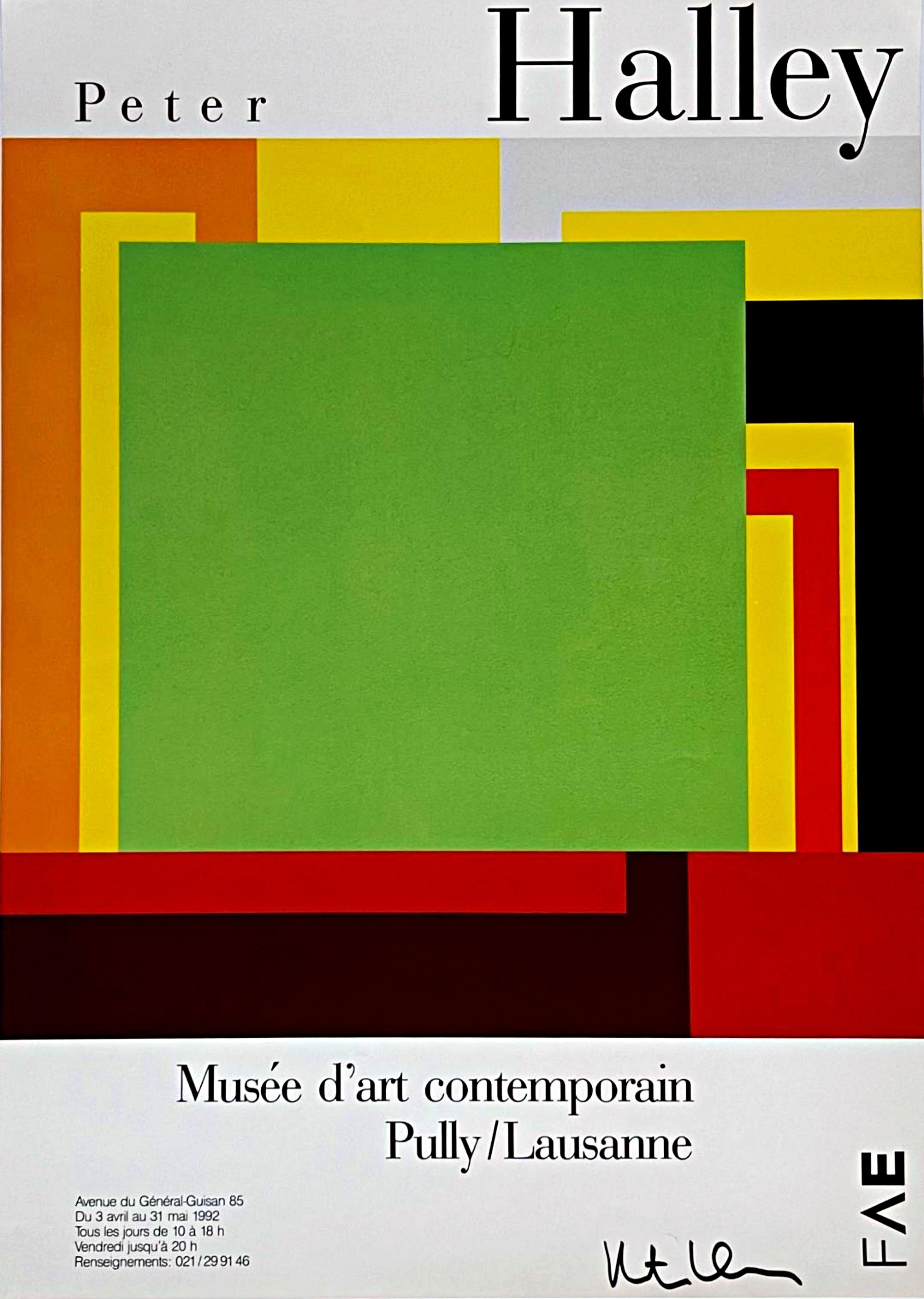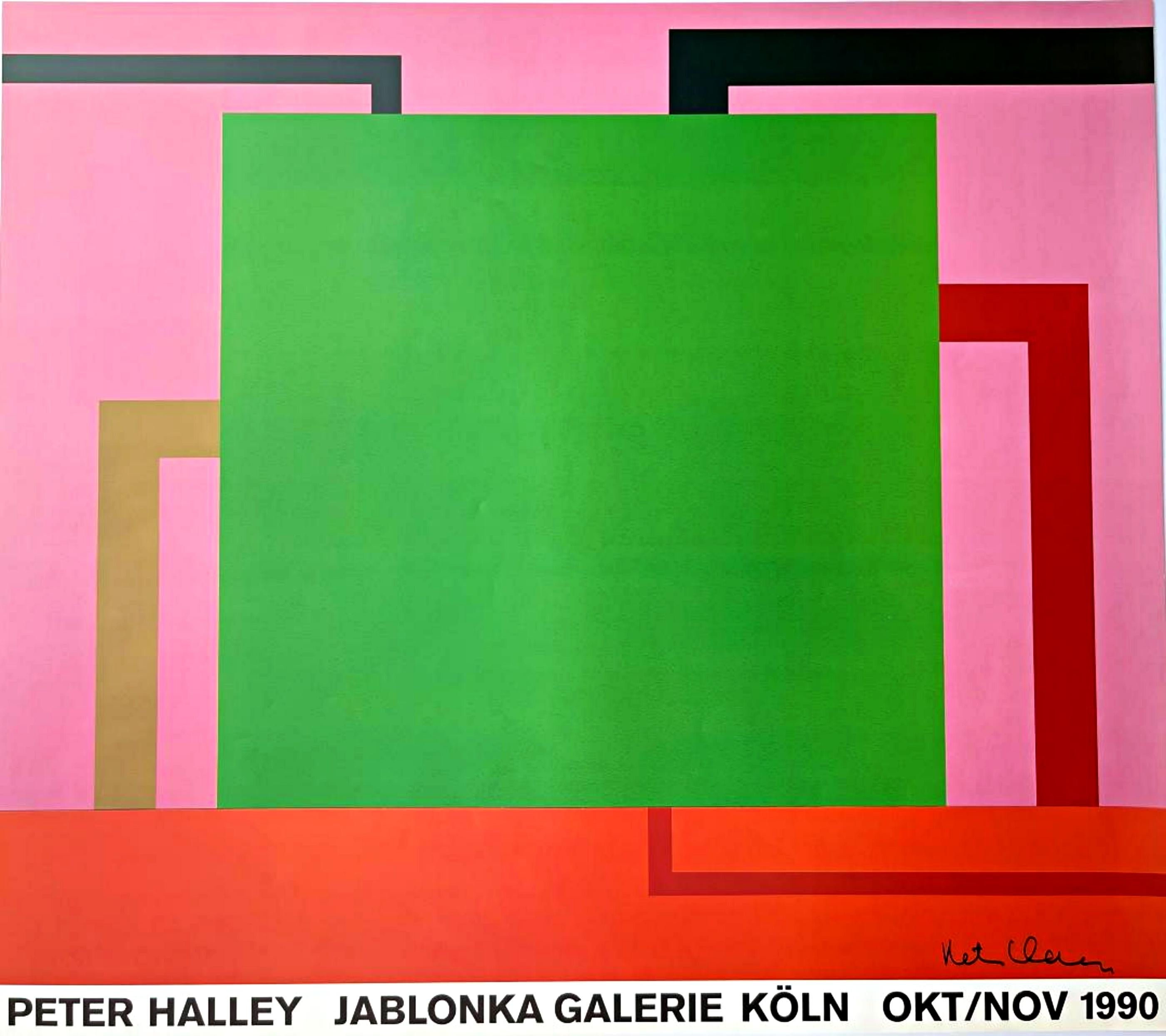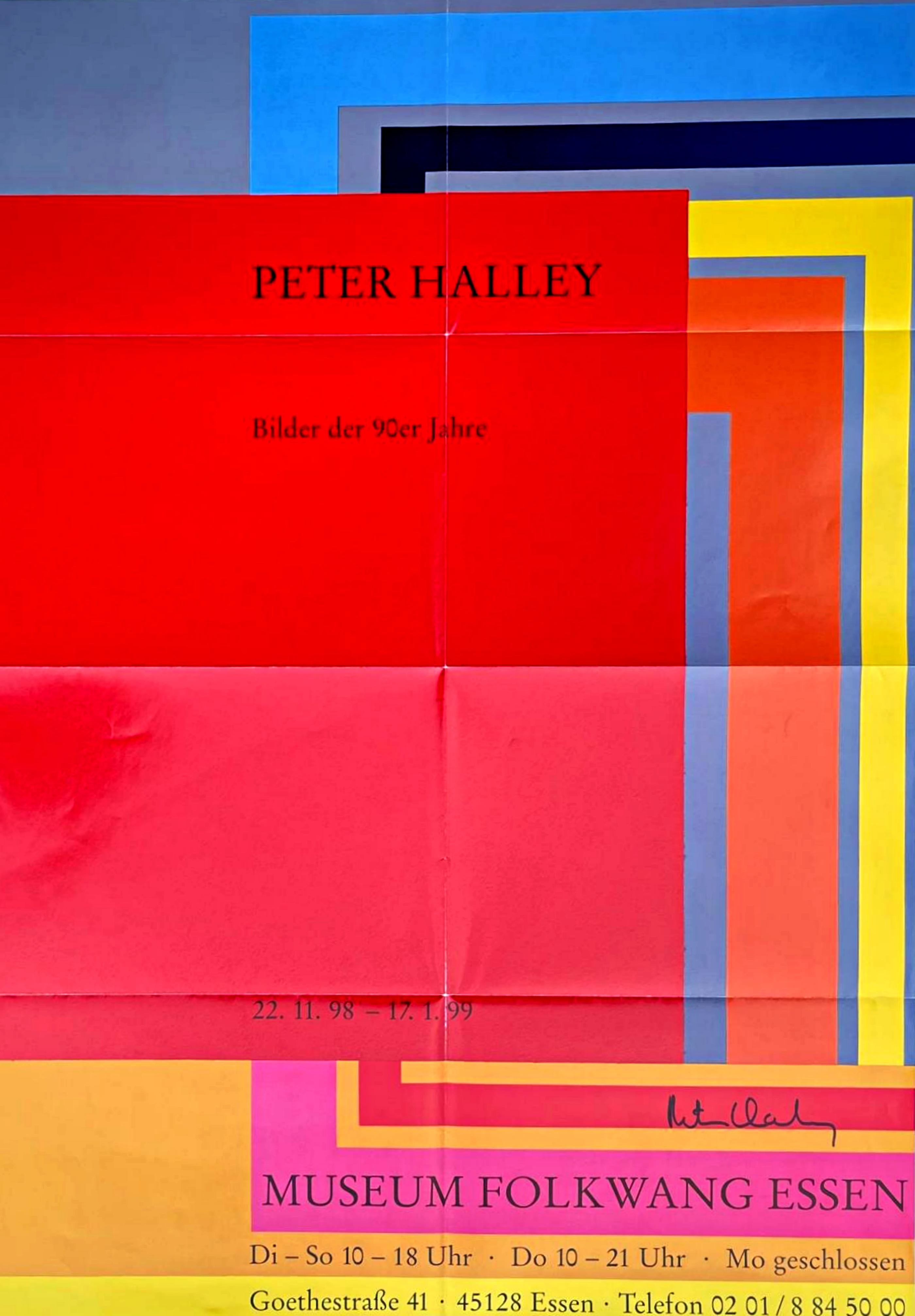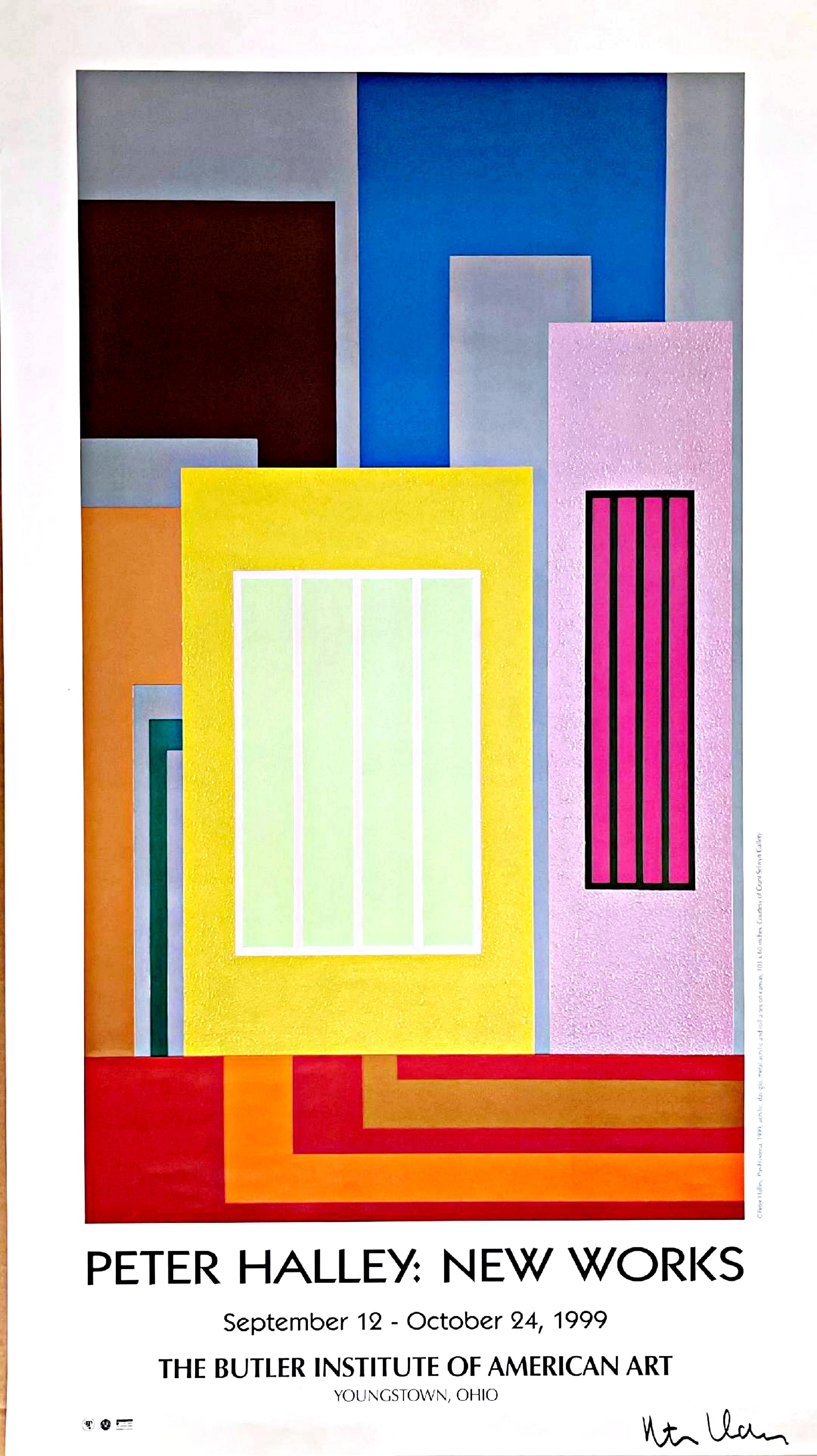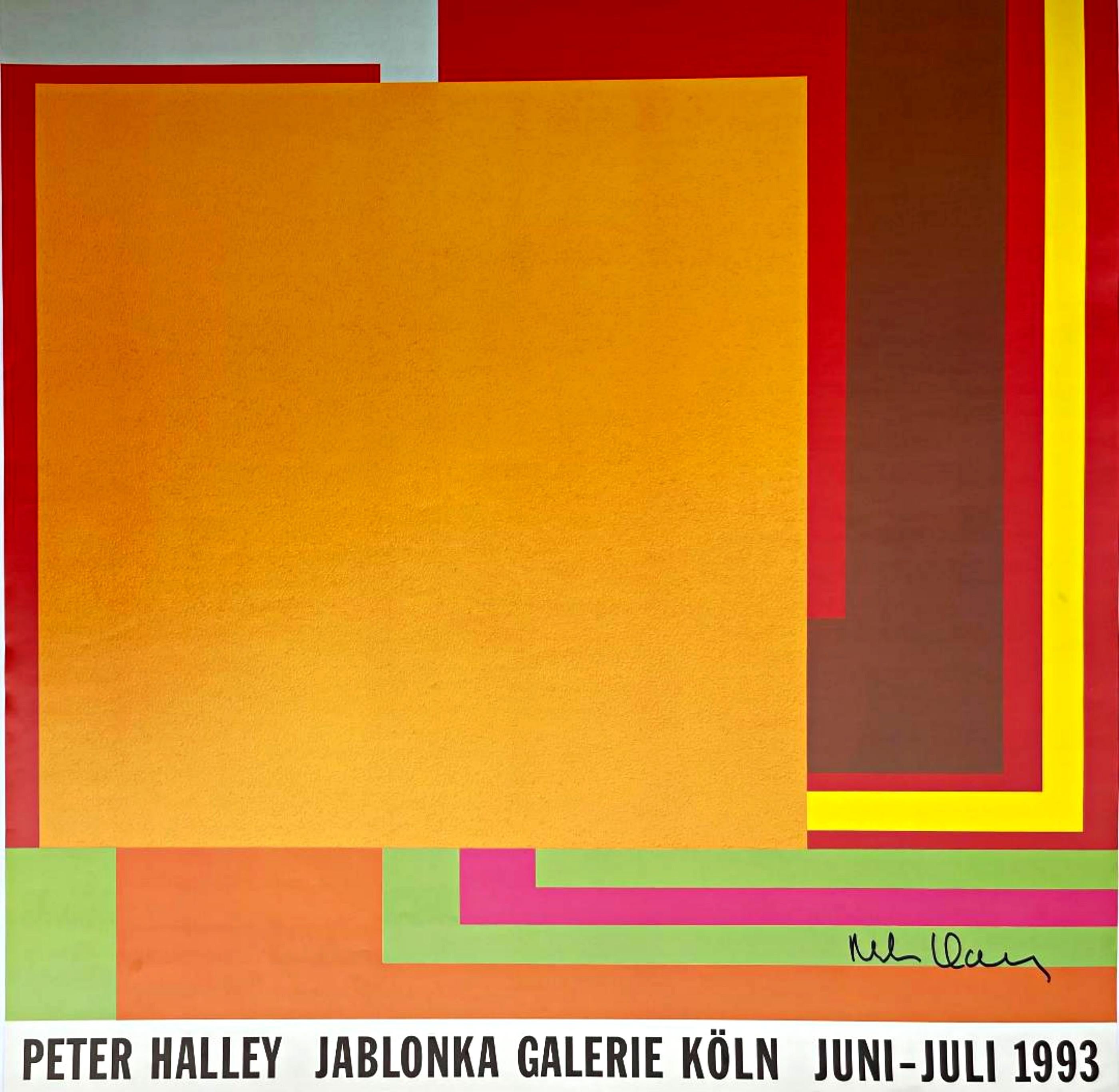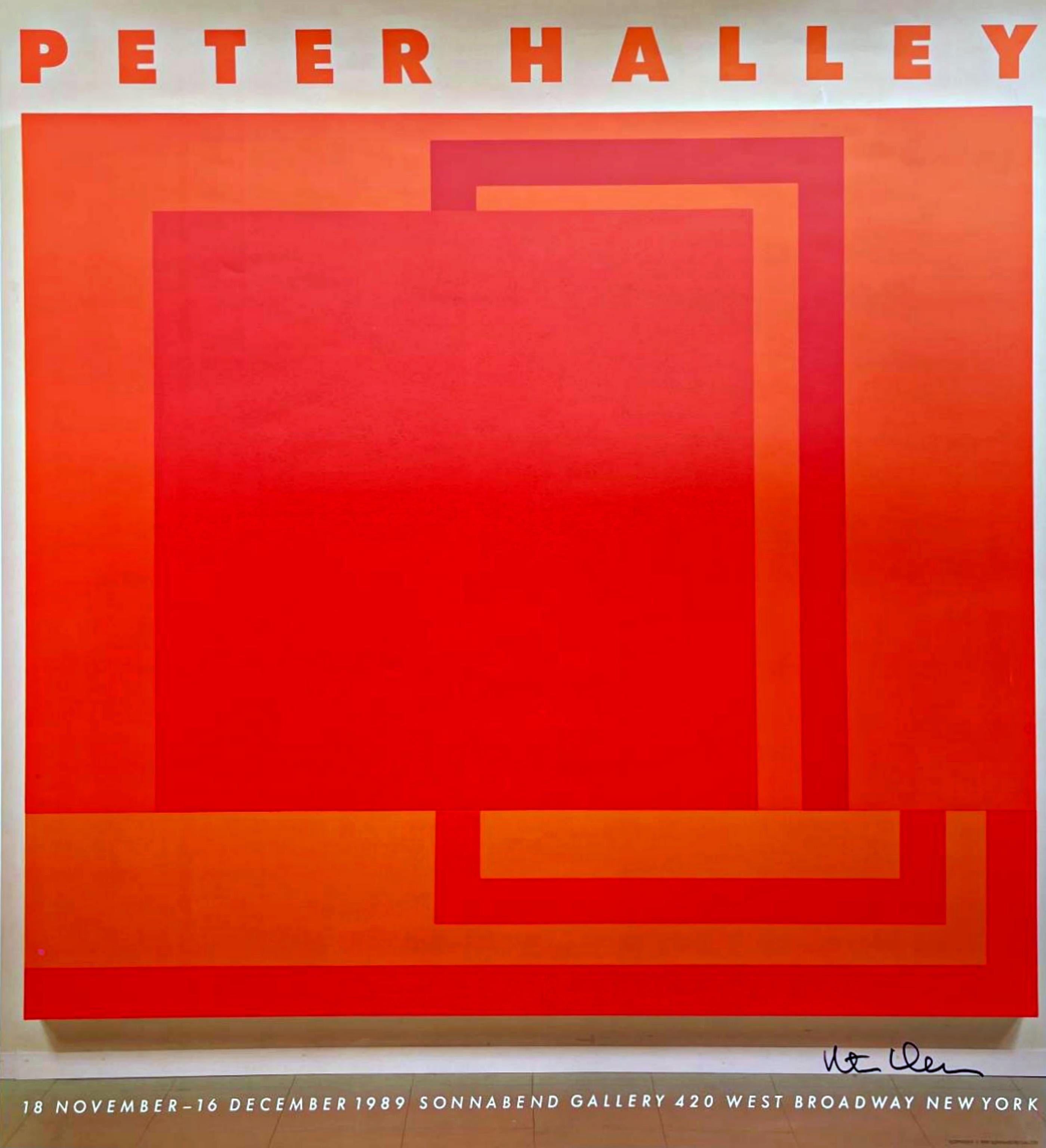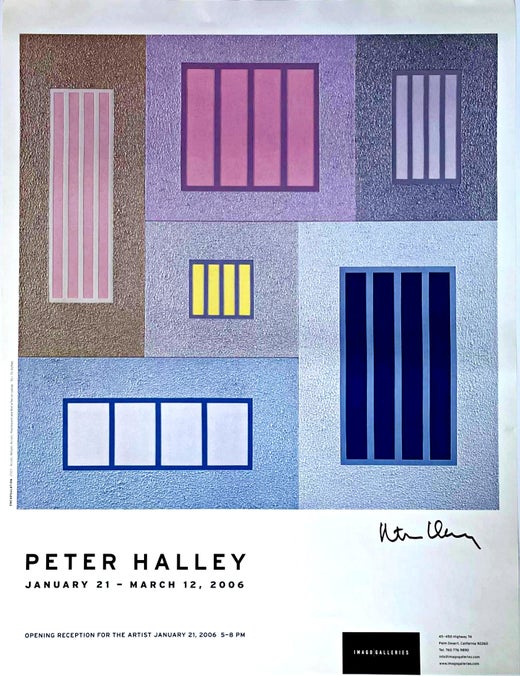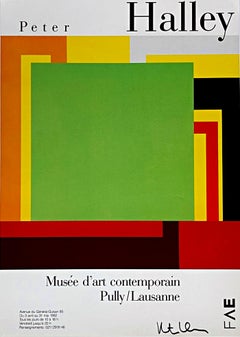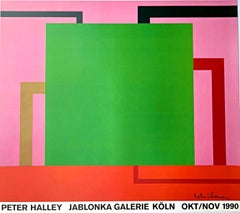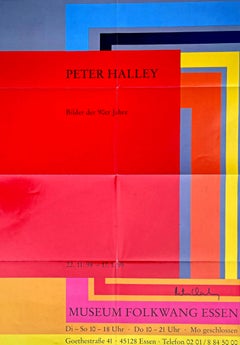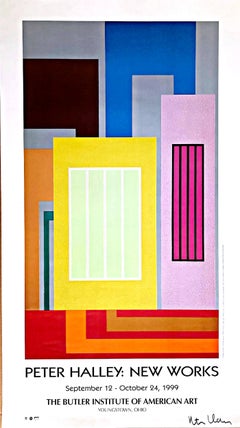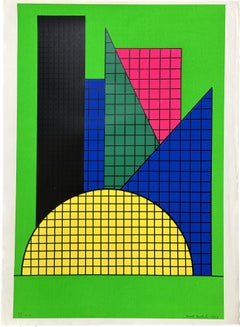Items Similar to Musée d'art moderne et contemporain Saint-Étienne Métropole, Hand Signed poster
Want more images or videos?
Request additional images or videos from the seller
1 of 7
Peter HalleyMusée d'art moderne et contemporain Saint-Étienne Métropole, Hand Signed poster2014
2014
$1,000
£757.69
€869.39
CA$1,407.16
A$1,546.86
CHF 812.96
MX$18,784.48
NOK 10,141.44
SEK 9,608.30
DKK 6,488.47
About the Item
Peter Halley, Musée d'art moderne et contemporain - Saint-Étienne Métropole, France (Hand signed), 2014
Offset lithograph (Hand Signed by Peter Halley)
23 1/2 × 16 inches
Boldly signed in black marker on the front
Unframed
Historic offset lithograph of legendary American artist Peter Halley's 2014 exhibition at the Musée d'art moderne et contemporain - Saint-Étienne Métropole, France which the artist hand signed in black marker.
Included in this listing is a photograph of our director Nadine Witkin with the artist at Peter Halley's studio.
Below is Peter Halley's official biography. What it doesn't mention is that Andy Warhol famously painted his portrait in 1986! Peter Halley is that legendary. According to Halley, he didn't realize until after Warhol's death that the polaroids Warhol took of him with his famous "big shot" camera were made into an original painting. Warhol's painting of Peter Halley was included in the recent Andy Warhol retrospective "Andy Warhol - from A to B and Back Again" at the Whitney.
PETER HALLEY BIOGRAPHY
Peter Halley, born 1953, New York City, is an American artist who came to prominence as a central figure of the Neo-Conceptualist movement of the 1980s. His paintings redeploy the language of geometric abstraction to explore the organization of social space in the digital era.
Since the 1980s, Halley’s lexicon has included three elements: “prisons” and “cells,” connected by “conduits,” which are used in his paintings to explore the technologically determined space and pathways that regulate daily life. Using fluorescent color and Roll-a-Tex, a commercial paint additive that provides readymade texture, Halley embraces materials that are anti-naturalistic and commercially manufactured.
In the mid 1990s Halley pioneered the use of wall-sized digital prints in his site-specific installations. He has executed installations at Museo Nivola, Orani, Sardinia (2021); Greene Naftali, New York (2019); Venice Biennale (2019); Lever House, New York (2018); Schirn Kunsthalle, Frankfurt (2016); Disjecta, Portland (2012); the Gallatin School, New York University, (2008, 2017); the Museum of Modern Art, New York (1997); and the Dallas Museum of Art (1995). In 2005, Halley was also commissioned to create a monumental painting for Terminal D at the Dallas/Fort Worth International Airport, Texas.
Halley served as professor and director of the MFA painting program at the Yale School of Art from 2002 to 2011. From 1996 to 2005, Halley published INDEX Magazine, which featured interviews with figures working in a variety of creative fields. Halley is also known for his essays on art and culture, written in the 1980s and 1990s, in which he explores themes from French critical theory and the impact of burgeoning digital technology. His Selected Essays, 1981 – 2001, was published by Edgewise Press, New York, in 2013.Halley’s writings have been translated into Spanish, French, and Italian.
A catalogue raisonné, PETER HALLEY: Paintings of the 1980s, was published in 2018 by JRP Ringier.
Halley’s work can be found in the collections of the Museum of Modern Art, New York; Whitney Museum of American Art, New York; Solomon R. Guggenheim Museum, New York; Broad Art Foundation, Los Angeles; Museum of Contemporary Art, Los Angeles; San Francisco Museum of Modern Art; Boston Museum of Fine Arts; Dallas Museum of Art; Albright-Knox Art Gallery, Buffalo; Tate Modern, London; Stedelijk Museum, Amsterdam; Sammlung Marx, Berlin; Museo Nacional Centro de Arte Reina Sofia, Madrid; Museum of Contemporary Art, Tokyo; Seoul Museum of Art, among others.
- Creator:Peter Halley (1953, American)
- Creation Year:2014
- Dimensions:Height: 23.5 in (59.69 cm)Width: 16 in (40.64 cm)
- Medium:
- Movement & Style:
- Period:
- Condition:
- Gallery Location:New York, NY
- Reference Number:1stDibs: LU1745215099122
Peter Halley
Peter Halley is an American artist known for his distinctive geometric paintings that explore the intersection of technology, society, and architecture. Born in 1953 in New York City, Halley developed an early interest in art and went on to study at Yale University, where he received his Master of Fine Arts degree in 1978.Halley's work is characterized by vibrant, flat colors and repetitive, abstract forms, often resembling circuit boards or prison cells. His paintings reflect his fascination with the effects of technology on human interaction and the isolation of modern society. Halley coined the term "prison cells" to describe the confined spaces and social structures that he believes have been created by technology and urban architecture. Throughout his career, Halley has exhibited his work internationally, gaining recognition for his unique style and thought-provoking concepts. He has also been involved in art criticism and writing, contributing to various publications and expanding the discourse on contemporary art. Today, Peter Halley's art continues to captivate audiences, provoking discussions about the impact of technology on our lives and the nature of human connections in an increasingly digital world. His contributions have made him an influential figure in the field of contemporary art.
About the Seller
5.0
Platinum Seller
Premium sellers with a 4.7+ rating and 24-hour response times
Established in 2007
1stDibs seller since 2022
451 sales on 1stDibs
Typical response time: 2 hours
- ShippingRetrieving quote...Shipping from: New York, NY
- Return Policy
Authenticity Guarantee
In the unlikely event there’s an issue with an item’s authenticity, contact us within 1 year for a full refund. DetailsMoney-Back Guarantee
If your item is not as described, is damaged in transit, or does not arrive, contact us within 7 days for a full refund. Details24-Hour Cancellation
You have a 24-hour grace period in which to reconsider your purchase, with no questions asked.Vetted Professional Sellers
Our world-class sellers must adhere to strict standards for service and quality, maintaining the integrity of our listings.Price-Match Guarantee
If you find that a seller listed the same item for a lower price elsewhere, we’ll match it.Trusted Global Delivery
Our best-in-class carrier network provides specialized shipping options worldwide, including custom delivery.More From This Seller
View AllMusee d'Art Contemporain Pully/Lausanne poster (Hand Signed by Peter Halley)
By Peter Halley
Located in New York, NY
Peter Halley
Musee d'Art Contemporain Pully/Lausanne (Hand Signed), 1992
Offset lithograph poster (hand signed by Peter Halley)
11 1/2 × 16 1/2 inches
Unframed
Hand signed in black ...
Category
1990s Abstract Geometric Abstract Prints
Materials
Offset, Lithograph
Peter Halley, Jablonka Galerie Köln rare abstract exhibition print (Hand Signed)
By Peter Halley
Located in New York, NY
Peter Halley
Jablonka Galerie, Köln (Hand Signed), 1990
Offset lithograph (Hand Signed by Peter Halley)
26 1/2 × 30 inches (ships rolled in a tube 37 x 6 x 6)
Signed by Peter Halley ...
Category
1990s Abstract Geometric Abstract Prints
Materials
Lithograph, Offset, Permanent Marker
Museum of Folkwang, Essen, Germany rare poster (Hand Signed by Peter Halley)
By Peter Halley
Located in New York, NY
Peter Halley
Museum of Folkwang, Essen, Germany (Hand Signed by Peter Halley), 1998
Offset lithograph poster (hand signed by Peter Halley)
33 × 24 inches
Unframed
Alpha 137 Gallery is honored to offer this historic offset lithograph of legendary American artist Peter Halley's 1998- exhibition at the Museum of Folkwang, Essen, Germany,which the artist hand signed in black marker. Shown here is a photograph of our director Nadine Witkin with the artist.
Below is Peter Halley's official biography. What it doesn't mention is that Andy Warhol famously painted his portrait in 1986! Peter Halley is that legendary. According to Halley, he didn't realize until after Warhol's death that the polaroids Warhol took of him with his famous "big shot" camera were made into an original painting. Warhol's painting of Peter Halley was included in the recent Andy Warhol retrospective...
Category
1990s Abstract Geometric Abstract Prints
Materials
Lithograph, Offset
The Butler Institute of American Art poster (Hand Signed by Peter Halley)
By Peter Halley
Located in New York, NY
Peter Halley
New Works, The Butler Institute of American Art (Hand Signed), 1999
Offset lithograph poster (signed by Peter Halley)
38 × 21 1/2 inches
Boldly signed in black marker by...
Category
1990s Abstract Geometric Abstract Prints
Materials
Offset, Lithograph
Jablonka Galerie exhibition poster, Köln (Hand Signed by Peter Halley)
By Peter Halley
Located in New York, NY
Peter Halley, Jablonka Galerie, Köln (Hand Signed), 1993
Offset lithograph poster (hand signed by Peter Halley)
26 1/2 × 26 1/2 inches
Unframed
Alpha 137 Gallery is honored to offer ...
Category
1990s Abstract Geometric Abstract Prints
Materials
Offset, Lithograph
Peter Halley at Sonnabend Gallery poster, New York (Hand Signed by Peter Halley)
By Peter Halley
Located in New York, NY
Peter Halley
Peter Halley, Sonnabend Gallery, New York (Hand Signed by Peter Halley), 1989
Offset lithograph poster (hand signed by Peter Halley)
28 × 26 inches
Unframed
Alpha 137 Gallery is honored to offer this historic offset lithograph of American artist Peter Halley's 1989 exhibition at the legendary Sonnabend Gallery in New York which the artist hand signed in black marker.
Scroll down for a photograph of our director Nadine Witkin with the artist.
Below is Peter Halley's official biography. What it doesn't mention is that Andy Warhol famously painted his portrait in 1986! Peter Halley is that legendary. According to Halley, he didn't realize until after Warhol's death that the polaroids Warhol took of him with his famous "big shot" camera were made into an original painting. Warhol's painting of Peter Halley was included in the recent Andy Warhol retrospective "Andy Warhol - from A to B and Back Again" at the Whitney.
PETER HALLEY BIOGRAPHY
Peter Halley, born 1953, New York City, is an American artist who came to prominence as a central figure of the Neo-Conceptualist movement of the 1980s. His paintings redeploy the language of geometric abstraction to explore the organization of social space in the digital era.
Since the 1980s, Halley’s lexicon has included three elements: “prisons” and “cells,” connected by “conduits,” which are used in his paintings to explore the technologically determined space and pathways that regulate daily life. Using fluorescent color and Roll-a-Tex, a commercial paint additive that provides readymade texture, Halley embraces materials that are anti-naturalistic and commercially manufactured.
In the mid 1990s Halley pioneered the use of wall-sized digital prints in his site-specific installations. He has executed installations at Museo Nivola, Orani, Sardinia (2021); Greene Naftali...
Category
1980s Abstract Geometric Abstract Prints
Materials
Offset, Lithograph
You May Also Like
Untitled I, Abstract Geometric Screenprint by Yves Millecamps
By Yves Millecamps
Located in Long Island City, NY
Artist: Yves Millecamps, French (1930 - )
Title: Untitled I
Year: Circa 1979
Medium: Screenprint, signed and numbered in pencil
Edition: AP
Paper Size: 30.5 x 30.5 in. (77.47 x ...
Category
1970s Pop Art Abstract Prints
Materials
Screen
Jean Marie Haessle Abstract Geometric Op Art Silkscreen Lithograph Print
By Jean-Marie Haessle
Located in Surfside, FL
Jean Marie Haessle, French-American (1939-)
Serigraph silkscreen
Hand signed in pencil and numbered
Elana's Dream (red background)
1980
Jean Marie Haessle was born in 1939 in Alsa...
Category
1980s Abstract Geometric Abstract Prints
Materials
Lithograph, Screen
Derek Boshier ONE 1967 Signed Limited Edition Silkscreen
By Derek Boshier
Located in Rochester Hills, MI
Derek Boshier
ONE - 1967
Print - Silkscreen 22½'' x 31'' in.
Edition: Signed in pencil, titled, dated and marked 36/70
Small creases and cracked ink in silkscreen. Otherwise very g...
Category
1960s Abstract Geometric Abstract Prints
Materials
Screen
$800 Sale Price
20% Off
Colored Geometrical Pattern - Original handsigned Screen Print /60ex
By Nivése
Located in Paris, IDF
Oscari NIVESE
Colored Geometrical Pattern
Original screen print
Handsigned in pencil
Numbered / 60 ex
On vellum 38 x 56 cm (c. 15 x 22 inch)
Excellent condition
Category
1990s Abstract Geometric Abstract Prints
Materials
Screen
Color School Hard Edge Geometric Silkscreen by Howard Mehring
By Howard Mehring
Located in Washington, DC
Silkscreen by Washington Color School artist Howard Mehring (1931-1978). Work is printed on thick wove paper circa 1970. Work was originally acquired from artists estate and is uns...
Category
1970s Color-Field Abstract Prints
Materials
Archival Paper
Abstract Composition - Screen Print by Max Bill - 1970s
By Max Bill
Located in Roma, IT
Abstract Composition is an original Screen Print realized by Max Bill in 1970s.
Good conditions.
The artwork is depicted harmonious colors in a well-balanced composition.
Category
1970s Abstract Geometric Abstract Prints
Materials
Screen
